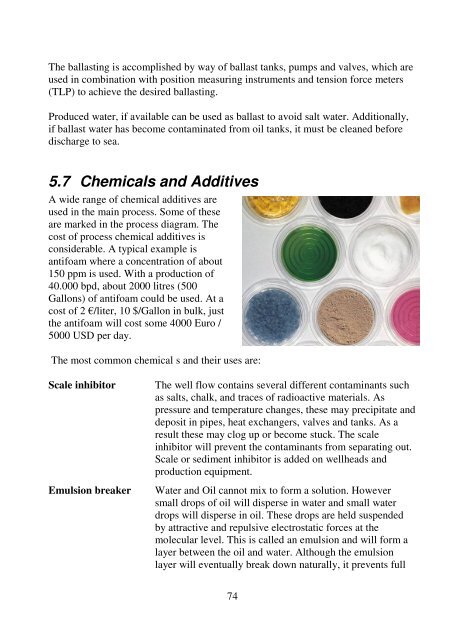Oil and gas production handbook - Process Control and ...
Oil and gas production handbook - Process Control and ...
Oil and gas production handbook - Process Control and ...
Create successful ePaper yourself
Turn your PDF publications into a flip-book with our unique Google optimized e-Paper software.
The ballasting is accomplished by way of ballast tanks, pumps <strong>and</strong> valves, which are<br />
used in combination with position measuring instruments <strong>and</strong> tension force meters<br />
(TLP) to achieve the desired ballasting.<br />
Produced water, if available can be used as ballast to avoid salt water. Additionally,<br />
if ballast water has become contaminated from oil tanks, it must be cleaned before<br />
discharge to sea.<br />
5.7 Chemicals <strong>and</strong> Additives<br />
A wide range of chemical additives are<br />
used in the main process. Some of these<br />
are marked in the process diagram. The<br />
cost of process chemical additives is<br />
considerable. A typical example is<br />
antifoam where a concentration of about<br />
150 ppm is used. With a <strong>production</strong> of<br />
40.000 bpd, about 2000 litres (500<br />
Gallons) of antifoam could be used. At a<br />
cost of 2 /liter, 10 $/Gallon in bulk, just<br />
the antifoam will cost some 4000 Euro /<br />
5000 USD per day.<br />
The most common chemical s <strong>and</strong> their uses are:<br />
Scale inhibitor<br />
Emulsion breaker<br />
The well flow contains several different contaminants such<br />
as salts, chalk, <strong>and</strong> traces of radioactive materials. As<br />
pressure <strong>and</strong> temperature changes, these may precipitate <strong>and</strong><br />
deposit in pipes, heat exchangers, valves <strong>and</strong> tanks. As a<br />
result these may clog up or become stuck. The scale<br />
inhibitor will prevent the contaminants from separating out.<br />
Scale or sediment inhibitor is added on wellheads <strong>and</strong><br />
<strong>production</strong> equipment.<br />
Water <strong>and</strong> <strong>Oil</strong> cannot mix to form a solution. However<br />
small drops of oil will disperse in water <strong>and</strong> small water<br />
drops will disperse in oil. These drops are held suspended<br />
by attractive <strong>and</strong> repulsive electrostatic forces at the<br />
molecular level. This is called an emulsion <strong>and</strong> will form a<br />
layer between the oil <strong>and</strong> water. Although the emulsion<br />
layer will eventually break down naturally, it prevents full<br />
74
















